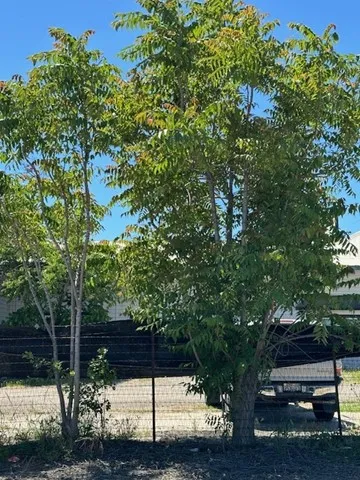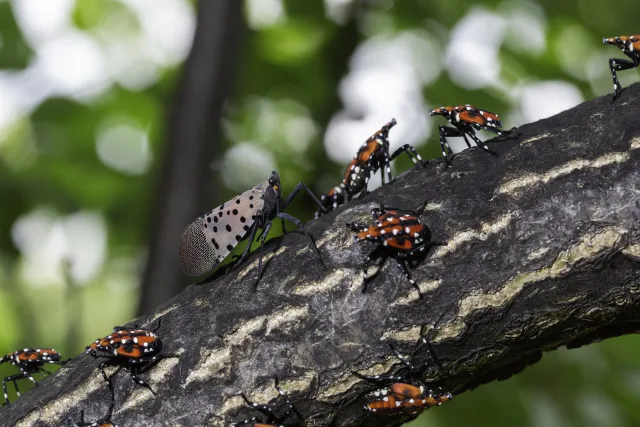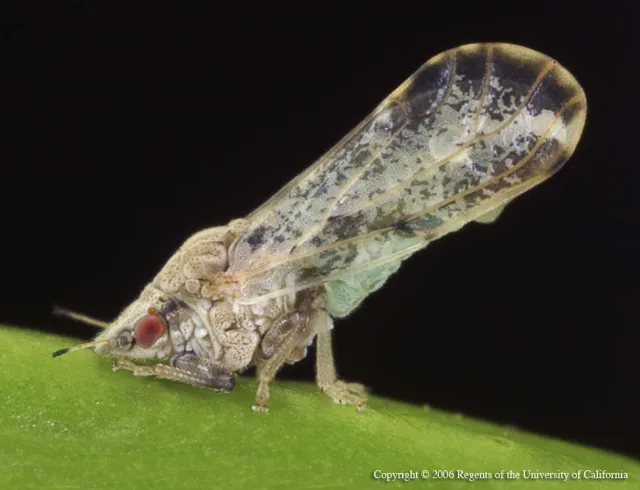The Issue
Across California’s diverse ecosystems and landscapes, invasive plants and pests disrupt native habitats, endanger wildlife, and jeopardize our food supply. They arrive in surprising ways, tucked inside produce shipments, hiding in camping gear, or introduced through well-intended but harmful landscaping choices.
Once established, invasive species can spread rapidly, outcompeting native species for vital resources like water, sunlight, and space. The numbers are staggering. According to the UC Riverside Center for Invasive Species, “on average, California acquires around nine new species of macro-invertebrate per year, of which around three will become pests. This is a rate of one new species every 40 days.” The impact isn’t just environmental, it’s economic. Invasive pests cost California’s agriculture industry an estimated $3 billion annually in crop losses and damage, and invasive plants now infest over 20 million acres of California’s wildlands — nearly one-fifth of the state. Research also shows that monitoring and early intervention can dramatically reduce long-term costs and ecological damage, as rapid response is far more effective than eradication once an invasive species becomes established (California Department of Food and Agriculture, n.d., 2024).

Spotted Lanternfly
The spotted lanternfly (Lycorma delicatula), an invasive leafhopper, is currently devastating crops in the eastern United States and poses a significant risk to California’s agriculture. These insects target essential crops, including grapevines and fruit trees, making early detection before establishment crucial. If the spotted lanternfly becomes established in California, it could threaten the state’s multibillion-dollar agriculture industry and the communities that rely on it.
Shothole Borer
In late 2023 the detection of another invasive pest, the shothole borer (Euwallacea fornicatus), in San Jose underscored the critical importance of early intervention. Despite its tiny size, no larger than a sesame seed, the shothole borer poses a significant threat to fruit, shade, and ornamental trees and shrubs. It tunnels into trees, introducing a fungus that serves as its primary food source. As the fungus spreads, it causes a disease that can kill branches or an entire stand of trees. The potential consequences of inaction are severe. Beatriz Nobua-Behrmann, UC Cooperative Extension Urban Forestry Advisor for Los Angeles and Orange counties, illustrates the impact, “In one regional park, about 500 trees had to be removed in under a year. That kind of devastation occurred in many locations—a whole street might suddenly lose 90% of its trees.”
African Tulip Tree
In San Diego County, what began as a collaborative research project between UC Cooperative Extension and UC Master Gardener volunteers revealed a potential unexpected threat to California’s native bee populations. The African tulip tree (Spathodea campanulate), prized for its vibrant orange and yellow blooms, appears to be harmful to native pollinators, potentially disrupting local ecosystems and pollination networks.
Asian Citrus Psyllid
For Ventura County residents, citrus trees are more than just part of the landscape; they are a source of pride. So, when the Asian citrus psyllid (Diaphorina citri) emerged as a serious threat, the community needed answers. In California, the spread of the Asian citrus psyllid threatens the state’s iconic citrus industry by transmitting Huanglongbing (citrus greening disease), which is fatal to citrus trees and has no known cure.
How UC Delivers
The UC Master Gardener Program offers hope on the front lines of this fight against invasive species, educating communities, promoting responsible gardening practices, and working on projects that help detect and manage invasives before they become established. Through partnerships with the California Department of Food and Agriculture (CDFA), UC Integrated Pest Management Program (UC IPM), and citizen science initiatives, UC Master Gardeners are playing a critical role in protecting California’s landscapes and biodiversity.

Spotted Lanternfly
The spotted lanternfly’s preferred host is the tree-of-heaven (Ailanthus altissima), an invasive, fast-growing tree that aggressively outcompetes native vegetation. Identification and mapping tree-of-heaven is a key strategy in tracking the arrival and spread of the spotted lanternfly, as it relies heavily on this tree during its lifecycle. To mitigate the potential spread of this destructive pest, UC Master Gardeners are working in collaboration with the CDFA to identify and map tree-of-heaven locations.
African Tulip Tree
Data collection done by UC Master Gardeners and Eric Middleton, PhD, Area Integrated Pest Management Advisor in San Diego found multiple dead native bees and numerous other dead insects inside African tulip tree flowers.
Asian Citrus Psyllid
When Asian Citrus Psyllid was discovered in California, UC Master Gardeners stepped up, determined to help residents stop the spread of the pest. Recognizing the urgent need for education, longtime volunteers Bonnie Brown and Linda Haque immersed themselves in state-level training and began sharing critical information with the public.
The Impact
From neighborhood backyards to regional parks, UC Master Gardeners are delivering real-world results in the fight against invasive species. By combining science-based training with deep community roots, volunteers are helping California stay ahead of emerging threats through early detection, mapping, education, and strategic partnerships. Their work is making a measurable difference, protecting ecosystems, supporting agriculture, and empowering Californians with the knowledge to act.
Spotted Lanternfly
The spotted lanternfly has mobilized UC Master Gardeners across California, who have identified over 76,000 tree-of-heaven trees at more than 5,000 locations statewide. “I have tree-of-heaven in my neighborhood, and it’s sprouted from roots in my backyard, so I know how insidious it is. I’m highly motivated to eliminate it from our county,” shared one UC Master Gardener. By increasing awareness of where these trees are established, this targeted effort informs efficient monitoring, early intervention and effective management strategies to prevent the spotted lanternfly from gaining a foothold in California.
Shothole Borer
Drawing upon over a decade of experience in Southern California, where shothole borers have caused widespread devastation, UC Master Gardeners are playing a crucial role in helping communities recognize early signs of infestation before the pest becomes established. Their efforts are a key component of early detection that relies on strong collaboration between dedicated volunteers and scientific experts. Alongside the UC Environmental Stewards Program, UC Master Gardeners are trained to learn how to identify and report infested trees with up to 96% accuracy.
“Because experts across the broader UC ANR network have many years of firsthand experience with this invasive pest, we are able to draw on their practical know-how to guide our monitoring, management, and public education efforts.” - Sara Davis, City Forester for City of San José
As one volunteer put it, they are “part of the solution,” keeping watch today to safeguard the environment for our future. Their passion led to the creation of the UC Master Gardener Program of Ventura County’s Invasive and Beneficial Pest Outreach Group, dedicated to invasive species outreach and education.
African Tulip Tree
“In 2022 and 2023 we sampled ~50 trees, checked ~9,500 African tulip tree flowers, and found a total of 1,214 dead insects inside, including 241 dead bees,” reports Middleton. UC Master Gardener volunteers were central to this effort, helping to collect data across San Diego and Orange counties. “
“I was happy to participate in an activity that could bring about greater public awareness of potential risks to native species when introducing exotic plants -- gorgeous though they may be -- into the environment.” - Mary Manaster, UC Master Gardener of San Diego
Building on these findings, Middleton is now seeking additional research funding to expand sampling efforts and determine the broader scope of risk African tulip trees pose to California’s native pollinators.

Asian Citrus Psyllid
Through partnerships with the CDFA and mandatory training for all of Ventura County’s UC Master Gardeners, Asian citrus psyllid awareness became a key message in every public presentation, reaching thousands across the county. The help desk fields questions, demonstration gardens showcase sustainable pest management strategies, and research-backed materials ensure that every resident who attends their workshops leaves with the knowledge to help protect their trees and community.
“I’m a boots on the ground volunteer that likes to talk to people one-on-one about invasive species. It is wonderful to be able to speak to the public and educate them about the least environmentally toxic method to save the environment and manage a pest program in the garden.”- Bonnie Brown, UC Master Gardener of Ventura County
Ventura County’s efforts have been so impactful that they are now expanding their work to include giant whitefly (Aleurodicus dugesii) and mosquito control in partnership with vector agencies. UC Master Gardeners continue to prove that community-driven education is one of the most powerful tools in the fight against invasive species.

